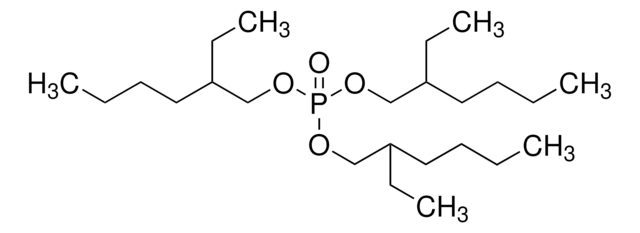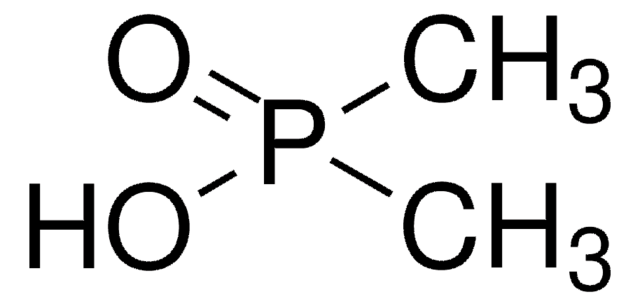68572
Dibutyl phosphate
≥97.0% (T)
Sinonimo/i:
Phosphoric acid dibutyl ester
About This Item
Prodotti consigliati
Livello qualitativo
Saggio
≥97.0% (T)
Forma fisica
liquid
Densità
1.06 g/mL at 20 °C (lit.)
Stringa SMILE
CCCCOP(O)(=O)OCCCC
InChI
1S/C8H19O4P/c1-3-5-7-11-13(9,10)12-8-6-4-2/h3-8H2,1-2H3,(H,9,10)
JYFHYPJRHGVZDY-UHFFFAOYSA-N
Cerchi prodotti simili? Visita Guida al confronto tra prodotti
Descrizione generale
Applicazioni
- Glycosyl phosphates by using 1,2-orthoesters.
- 2-Aminophosphatesvia catalyst-free regioselective and enantiospecific SN2-type ring opening reaction with aziridines.
Caratteristiche e vantaggi
- Inherently biodegradable
- Stable in neutral, acidic, or alkaline solutions
Avvertenze
Danger
Indicazioni di pericolo
Classi di pericolo
Carc. 2 - Eye Dam. 1 - Skin Corr. 1B
Codice della classe di stoccaggio
8A - Combustible corrosive hazardous materials
Classe di pericolosità dell'acqua (WGK)
WGK 1
Punto d’infiammabilità (°F)
352.4 °F - closed cup
Punto d’infiammabilità (°C)
178 °C - closed cup
Dispositivi di protezione individuale
Eyeshields, Gloves, type ABEK (EN14387) respirator filter
Scegli una delle versioni più recenti:
Possiedi già questo prodotto?
I documenti relativi ai prodotti acquistati recentemente sono disponibili nell’Archivio dei documenti.
I clienti hanno visto anche
Il team dei nostri ricercatori vanta grande esperienza in tutte le aree della ricerca quali Life Science, scienza dei materiali, sintesi chimica, cromatografia, discipline analitiche, ecc..
Contatta l'Assistenza Tecnica.


![1,8-diazabiciclo[5.4.0]undec-7-ene 98%](/deepweb/assets/sigmaaldrich/product/structures/120/564/5b373e23-1624-489c-8efb-692de0f96ffb/640/5b373e23-1624-489c-8efb-692de0f96ffb.png)




![1,4-Diazabicyclo[2.2.2]octane ReagentPlus®, ≥99%](/deepweb/assets/sigmaaldrich/product/structures/366/129/a6ff4175-974d-4fac-9038-b35e508ef252/640/a6ff4175-974d-4fac-9038-b35e508ef252.png)





